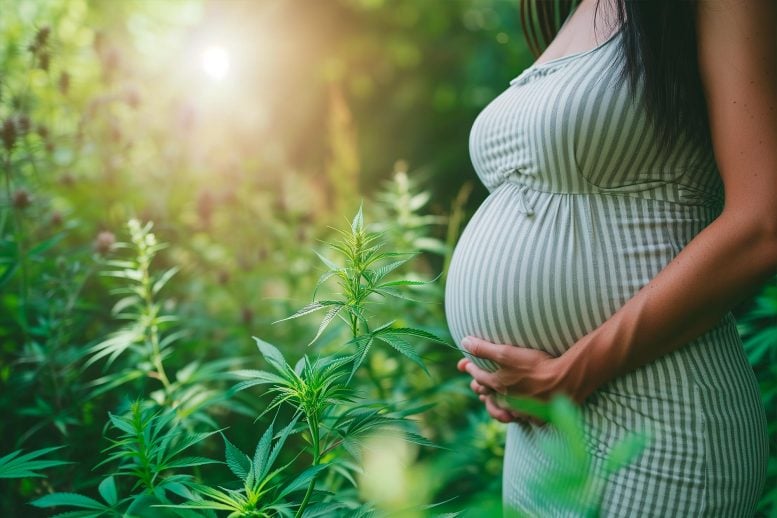Unveiling the Secret Risks of Prenatal Cannabis Exposure

Recent research at Washington University has explored how prenatal exposure to cannabis might affect neurodevelopment, revealing possible biological mechanisms linking such exposure to mental health issues in later childhood and adolescence. Credit: SciTechDaily.com
New research links prenatal cannabis exposure to potential developmental and mental health issues through changes in brain structure and function, based on findings from neuroimaging data.
Scientists are trying to understand how cannabis may affect long-term neurodevelopment when people are exposed to it in the womb. Previous work by Washington University in St. Louis researchers Sarah Paul and David Baranger in the Behavioral Research and Imaging Neurogenetics (BRAIN) lab led by Ryan Bogdan found associations between prenatal cannabis exposure and potential mental health conditions in childhood and adolescence, but potential biological mechanisms that could possibly explain this association were unclear.
In research published in Nature Mental Health this month, Bogdan, the Dean’s Distinguished Professor of Psychological & Brain Sciences at WashU, and Postdoctoral Fellow Baranger, outline some of those potential mechanisms, the intermediate biological steps that could play into how prenatal cannabis exposure leads to behavioral issues down the line.
“We see evidence that cannabis exposure may influence the developing brain, consistent with associations with mental health,” said Baranger.
Trying to draw out the long-term impacts of cannabis exposure during pregnancy is not a simple knot to untangle. There are many confounding factors that affect mental health and behavior. For example, say someone was exposed to cannabis in utero and later develops attention deficit disorder as a teen—how do you differentiate that as an inherited trait, or a trait influenced by environmental factors, versus a trait that was influenced by cannabis exposure early in development? Or all three processes could contribute to eventual psychopathology. Another complication is the increasing prevalence of cannabis use, including among the pregnant population where cannabis use has increased from 3 to 7 percent from 2002 to 2017.
Researchers used statistical methods to filter out some of these confounding factors and to suggest potential biological measurements between prenatal cannabis exposure and types of adolescent behavior.
Nothing can 100 percent establish causation “but we can look at the plausibility of causation, and identifying potential biological correlates that are associated with cannabis exposure and these mental health outcomes suggests it’s plausible,” said Bogdan about the study results.
Researchers have been using data from the Adolescent Brain and Cognitive Development (ABCD) Study, an ongoing research project that includes nearly 12,000 children across the United States. As part of that study, researchers collected data about each mother’s substance use prior to the birth and neuroimaging data at ages 9-10 and 11-12. Some 370 children were exposed to cannabis prior to the mother’s knowledge of pregnancy, and 195 were exposed both before and after learning of pregnancy.
The researchers looked at a variety of neuroimaging measurements that are important in brain development, including measures of brain thickness and surface area, as well as measures of water diffusion in and out of cells. The patterns found in the group of children exposed to cannabis before birth are consistent with potential reductions in neuroinflammation.
“It’s possible what we’re seeing is an anti-inflammatory effect of cannabis which is leading to differences in how the brain is being pruned during neuro development,” said Bogdan.
Much has been touted about the anti-inflammatory effects of cannabis, but it’s not always good to reduce inflammation. It’s all about the timing. Too much of a reduction of inflammation at the wrong time could affect how the brain is pruned and primed.
Another theory is that cannabis exposure leads to accelerated aging. But don’t expect to find the smoking gun of biological clues pinning mental health conditions to early cannabis exposure.
It might not even be about pruning. It might also not be from the cannabis use itself, but rather the post-combustion products from smoking cannabis that might set off accelerated aging and the downstream cognitive effects, said Bogdan.
Or, it’s all down to sociological factors.
Trying to find the one-to-one connection that proves that prenatal cannabis exposure has negative effects during the teenage years is a challenge and may not be possible with retrospective studies. Baranger notes that the major limitation of this data set is that it was retrospective; mothers reported what their cannabis use was 10 years ago, so he’s looking forward to new data from prospective, longitudinal studies that will offer more recent, accurate and detailed information about cannabis use in pregnancy.
“That will potentially give us more answers to these questions in the future.”
In the meantime, results from this study reaffirm that if you’re thinking about using cannabis while pregnant, “talk to your doctor about your choices and what other options there might be,” said Baranger.




